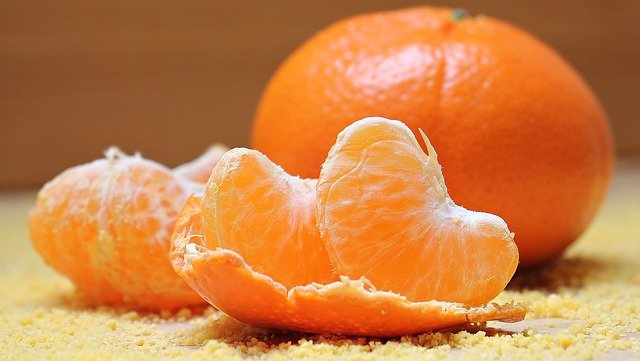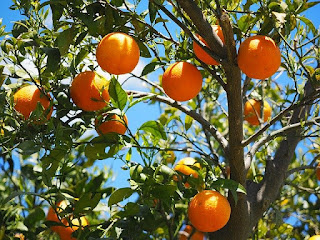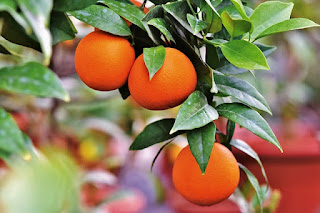Orange tree

Orange
trees are evergreen trees with a useful age of 50-60 years. Some orange
trees that are well cared for can live up to 100 years or more.
Learn more: Walnut Tree: Description, Ecology, Uses, Cultivation, Chemical Composition, and much more
The
tree is a flowering tree and its height at maturity can range between 16 and 50
feet (between 5m and 15m). Orange trees are grown mostly for their fruit,
but also for flowers and as ornamentals. Brazil is a world leader in orange
production, as, for every 4 oranges produced worldwide, more than 1 orange is
produced in Brazil. However, the United States, Mexico, India, and China
are also great orange producers.
Orange trees, like all oranges, are trees with
one main trunk. Their main arms usually grow from the stem at a height of
23-46 inches (60 to 120cm) from the ground. The trunk is cylindrical and
the crown of most cultivars is usually round, although the shape can vary
depending on how the tree is pruned.
Orange trees -although evergreen leaves-
are characterized by a tendency to continually renew their foliage. During
the first few years until the completion of tree formation, the annual number of
newly formed leaves is higher than that of older leaves which tend to
fall. Young leaves are light green in color and acquire a darker green
color gradually.
The berries are orange in color and the flesh
is orange to red, depending on the type. Both the fruit and leaf surfaces
are full of oleaginous glands, which give it a distinctive orange
aroma. Orange trees usually bloom in spring. Although they produce a
large number of flowers, only a small percentage of these eventually develop
into ripe fruit. Orange tree flowers are usually white, with a very
pleasant smell.
Morphology
Oranges are one of the fruit commodities that are highly
favored by the public, both in the form of fresh and processed products.
Fruit that has a sweet, sour taste and a lot of water content
is rich in vitamins, minerals, protein, calories, and fiber that are good for
the body.
In addition, orange fruits also contain beta carotene and thiamin. Plants that have a variety of species belong to the class of seed plants and are widely grown in the tropics.

Root
Orange roots consist of taproots, fibrous roots, and hair
roots. The taproot of orange plants can reach approximately 4 meters if the
roots get fertile soil and do not meet hard soil or watery soil. This is
because orange plants have a taproot with the root tip consisting of young
cells that are constantly dividing and are the growing point of orange roots.
These root cells are very soft, so they break easily if they penetrate hard and
dense soil.
Stem
The stem of the orange plant is round and covered with buds.
Some of the stems of orange plants look rough and prickly, but some have a
smooth surface, some oranges can reach a height of 15m and some only reach 5m
and have a variety of colors, it all depends on the type of orange plant
itself.
Leaf
The leaves of orange plants are oval in shape resembling eggs,
dark green, and look thick. There are no hairs on both sides of the leaf, and
the leaf bones are pinnately shaped, although some are alternate.
Flower
Oranges are compound flowering plants, pale white in color, and
are included in perfect flowers (in 1 flower there are 2 sexes or hermaphrodites).
Usually, orange flowers appear in the axils of leaves or twigs that are still
young and smell good because they contain large amounts of nectar/honey.
Fruit
There are orange fruits that are round, oval and some are oval with slightly elongated. Some of the fruit skins are thick and tough, some are thin and easy to peel, have yellow, orange, and green colors depending on the type.

Seed
In orange plants, seeds are found in the grain of the fruit,
the availability of seeds in orange plants depends on the variety, there are
many seeds to those without seeds. Orange seeds are usually white or
grayish-white, oval in shape and pointed at one end, polyembryonic with white
embryos.
How
to grow orange trees
1. The best growing soil: Orange trees are sunny, suitable for fertile,
loose, slightly acidic, well-drained sandy soil.
2. Growing humidity requirements: like a warm environment with certain
humidity, the potting soil should be kept moist, but no water should accumulate in
the pot. In summer to early autumn, when the weather is hot, in addition
to watering the basin, you should also spray water on the ground around the
basin to keep it moist.
3. Optimal growth temperature: Orange trees like warmth, are more
shade-tolerant, and are more sensitive to temperature than light. The
optimal growth temperature is centered at 26 degrees Celsius, and 23-34 degrees
Celsius is the most appropriate.
4. Optimal growth light: Orange is a fruit with strong negative
tolerance, but good sunshine is still needed for high-quality and high-yield.
Generally, areas with 1200-2200 hours of sunshine per year can grow normally
Orange planting
methods and precautions
1. Seedling planting: When orange seedlings are planted, the roots
of the seedlings are moderately pruned and placed in the center of the planting
hole. Pour enough root water to make a 1-meter tree disc around the
saplings and cover them with chaff. After orange seedlings are planted,
they should do a good job of deepening and expanding the hole and maturing the
soil. It is forbidden to plant high-stalk plants such as corn and wheat in the
garden.
2. Fertilizer and water management: Orange trees should fully meet the needs of
blood oranges for various nutrients, and encourage the application of more
organic fertilizers, rational application of inorganic fertilizers and formula
fertilizers, and based on the results of leaf analysis, orchard soil analysis
results, blood orange phenology, etc. Guide fertilization. Mainly
fertilize the soil with foliar fertilization. Adopt ring furrow
application, strip furrow application, hole application, and soil surface
fertilizer application methods. Irrigate the soil when it is dry and drain
when the water accumulates.
3. Reasonable fertilization: orange trees should be applied regularly and
thinly, with nitrogen fertilizer as the mainstay, combined with phosphorus and
potassium fertilizers, and fertilization during spring, summer, and autumn
shoot 5-6 times. Adult trees are given four times of fertilizer, namely,
germination fertilizer, fruit-preserving fertilizer, strong-fruit fertilizer,
and fruit-picking fertilizer, germination fertilizer 2-3 catties of chemical
fertilizer, one load of manure water, fruit-preserving fertilizer 1-2 catties
of phosphorus and potassium fertilizer, and 1 catty of chemical fertilizer.
Strong fruit fertilizer 1~2 catties of chemical fertilizer, 2 catties of phosphorus
and potassium fertilizer, 50~100 catties of organic fertilizer, and 2 catties of
chemical fertilizer for fruit-picking fertilizer plants.
4. Pruning technique: After the extension branches of the selected
category in the sapling stage and the extension branches of the main and
auxiliary main branches, they are moderately or severely shortened, and each
main branch is adjusted according to the degree of shortness and the direction
of the cutting bud. The balance of growth between branches. In the fruiting
period, continue to choose shortcuts to treat the backbone extension branches
at all levels, erase the summer shoots, and promote robust autumn
shoots. In autumn, flower promotion measures such as ring cutting, root
cutting, and water control are adopted for the prosperous trees.
What to do if orange
tree leaves turn yellow
Reasonable watering
The yellowing of
orange tree leaves may be caused by too hot weather and excessive water
loss. At this time, the amount of watering should be increased appropriately,
you can water once in the morning and at night, and pay attention to not too
much water at one time. In addition, you can spray water on the leaves or
spray water around the pot to increase the humidity of the air.
Fertilize correctly
Lack of nitrogen
fertilizer or boron fertilizer will make the leaves of orange trees yellow. At
this time, fertilizers containing nitrogen or boron must be applied. If
there is less nitrogen, you can apply farmyard manure or spray urea. If you
lack boron, you can apply boric acid. In addition, a boric acid solution is also
a good choice.
Change the soil quality
Orange trees are more
suitable for survival in acidic soil. If the soil is too alkaline, it may cause
its leaves to turn yellow or even drop their leaves. You can mix in a
little beer while watering, but be careful not to mix too much. In
addition, when choosing soil, choose fertile soil with better aeration. If it
is soil dug from the wild, it should be exposed to the sun.
Add multiple elements
Less iron, less zinc,
less manganese, etc. may cause the leaves of orange trees to turn yellow. At
this time, it is necessary to supplement the lack of this element
accordingly. If it is an iron deficiency, you can apply iron sulfate or a
small amount of sulfur powder, which can also increase the acidity of the
soil. If it is less zinc, you can spray zinc sulfate solution on the tips
of the leaves, paying attention to the concentration not too high. If it
is less manganese, manganese sulfate can be mixed with other fertilizers and applied
to it.
Pest control
Red spiders may also cause yellowing of orange tree leaves. At this time, you can spray it with 5000 times of Mite Suspension Agent. In addition, 15bf of mites can be cleaned by 1000 times.

How to keep orange
fresh
1. Garlic liquid to
keep orange fresh: Take a garlic clove and mash it into a puree form, put it
into 10 parts of boiling water, stir and take the liquid, cool to room
temperature, and then immerse the selected orange in the garlic liquid, take it
out and dry it after 10 minutes. Stored in a box or plastic bag, it can keep
fresh for 3 months.
2. Keep orange fresh
with soda water: Dilute 2 parts of soda and 1 part of water and stir into a
liquid, soak the orange for 2 minutes, remove and dry, put it in a plastic bag,
and tie the mouth of the bag tightly to keep 3 oranges fresh moon.
Pests
The aphids, these little creatures light green are seen with the naked eye under the leaves near the veins. To get rid of it organically, spray with soapy water, or a mixture of water and olive oil which will also nourish your plant.
Beware of mealybugs, those little biting and sap-sucking insects that quickly
weaken the most vigorous of trees. You will easily recognize them: the insects
lock themselves in a brown shell or under a white felt, on the back of the leaf
against the main vein and excrete honeydew that
will eventually attract fungi. To get rid of it without chemicals, three
solutions:
Get its natural predator, Cryptolaemus, a black Australian ladybird with white spots; use a male trap (attracted by pheromones, these are found stuck on the trap) or a product purchased in garden centers, having an active ingredient of plant origin, and certified for use in Organic Farming.
The orange tree is not immune to a leafminer attack. These caterpillars make small brownish galleries in the leaf blade, visible on the back of the leaf. They protect themselves in a waxy cuticle, so it is difficult to get rid of them. There is no organic treatment, the best is to cut and burn the affected leaves.
The foliage of the orange tree is discolored, its green turns to silver-gray,
small cobwebs are forming at the end of the leaves? Your orange tree is
attacked by red spiders. These
mites hate humidity, wash the plant with plenty of water. And adopt a few
red ladybugs, they are very fond of these mites, like aphids which can also
spread on the orange tree





No comments:
Please do not enter any spam message in the link.